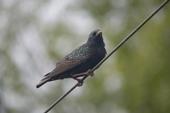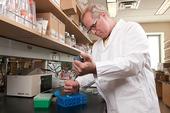- Author: Emily C. Dooley, UC Davis

E. coli and Salmonella are rare in wild birds, Campylobacter more common
Concerns over foodborne risk from birds may not be as severe as once thought by produce farmers, according to research from the University of California, Davis, that found low instances of E. coli and Salmonella prevalence.
While the research found that the risk is often low, it varies depending on species. Birds like starlings that flock in large numbers and forage on the ground near cattle are more likely to spread pathogenic bacteria to crops like lettuce, spinach and broccoli, according to a study of food safety risk and bird pathogens from the University of...
- Author: Roberta Barton

Discolored leaves. Decaying roots. Dead wood. Mother Nature offers a fascinating and colorful backdrop of clues to track microscopic killers. Much like any medical mystery, experts are called in to diagnose or identify a disease from its symptoms and recommend management strategies to prevent further damage or loss of healthy plants.
In the world of crop science mysteries, plant pathology solves the crime. The usual suspects include bacteria, fungi and viruses.
Humans and animals depend on plants for their food supply and ultimately for their survival. When diseases threaten crops, a high-quality, affordable food supply is placed at risk. For growers, plant diseases can reduce crop yields. For consumers, reduced...
- Author: Trina Wood

For home gardeners, spring is a busy time of year and there’s never a tomato with more flavor than one grown to full ripeness on the vine. But there are also many safety precautions to follow to prevent contamination of fruits and vegetables with pathogens that cause serious food-borne illnesses.
Michele Jay-Russell, a veterinarian and research microbiologist at the Western Institute for Food Safety and Security (WIFSS) and program manager of the Western Center for Food Safety (WCFS), recently co-authored a study that highlights the need to be aware of...
- Contributor: Ann King Filmer
- Author: Pat Bailey

An ambitious effort to sequence the genomes of 100,000 infectious microorganisms and speed diagnosis of foodborne illnesses has been launched by the University of California, Davis, Agilent Technologies, and the U.S. Food and Drug Administration.
Bart Weimer, professor in the UC Davis School of Veterinary Medicine, serves as director of the 100K Genome Project and co-director of the recently established BGI@UC Davis facility, where the sequencing will be done. Other collaborators include the U.S. Centers for Disease Control and Prevention and the U.S....
- Author: Ann King Filmer
![Food blog 01 5751417888 59f0a8c3ca m[1]](https://ucanr.edu/blogs/food/blogfiles/7859small.jpg)
Now that we’re in the thick of summer and eating bountiful quantities of uncooked fresh fruits and vegetables (salads, and fruit bowls, and tomatoes — oh my!), it’s time to make sure we handle them properly to avoid foodborne illnesses.
According to Dr. Trevlor Suslow, a plant pathologist and Cooperative Extension specialist at UC Davis, “Americans consume more than six billion servings of uncooked fresh fruits and vegetables every year, versus a very small number of illnesses that are clearly linked to foodborne pathogens.”
The take-home message is that the food supply in the U.S. is generally very safe, particularly when everyone in the food supply chain (including consumers) does their part to assure food...



